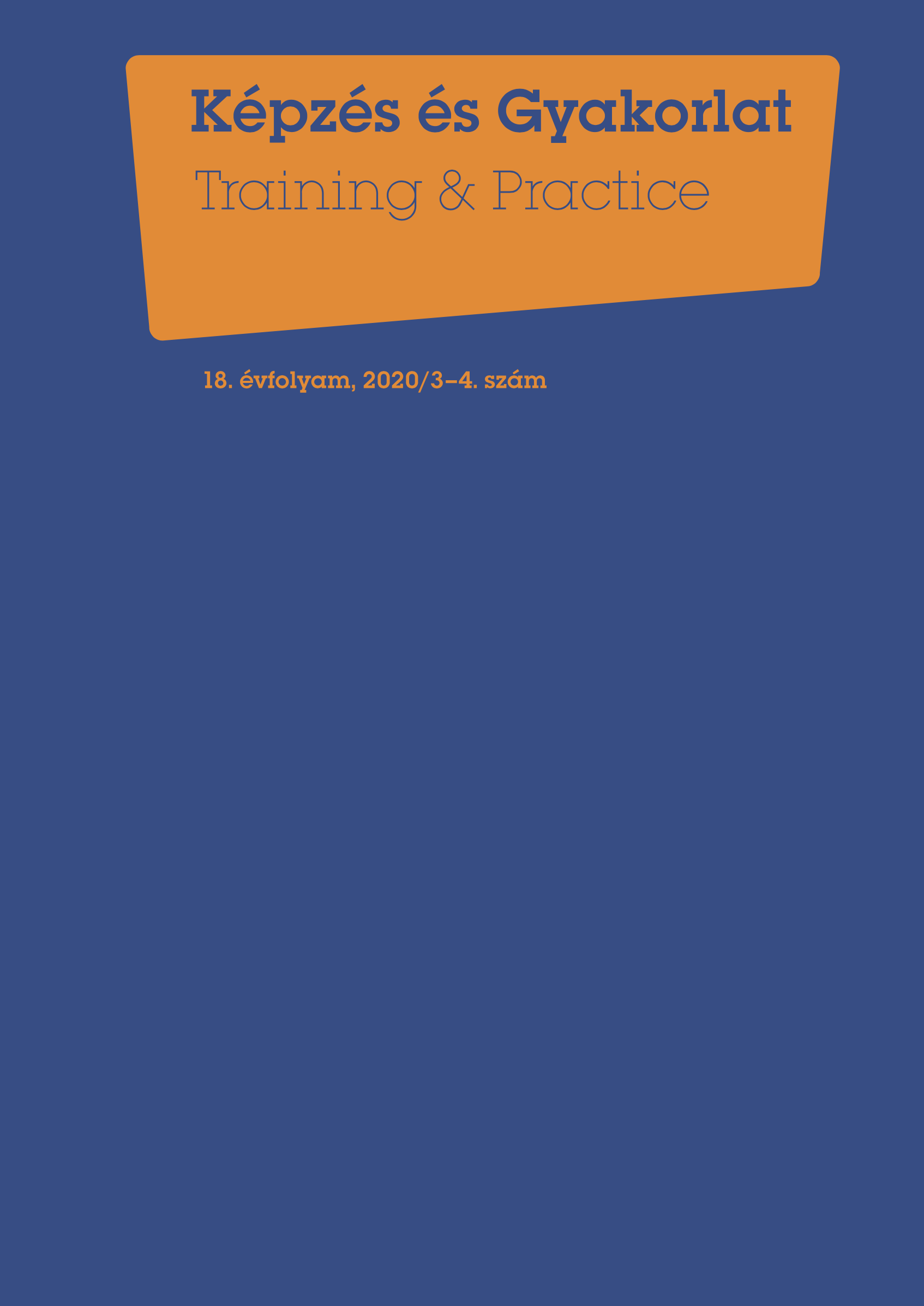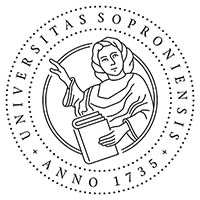CLIL tanulók nyelvtanulásról alkotott nézetei a nyelvórai IKT eszközintegráció tükrében
DOI:
https://doi.org/10.17165/TP.2020.3-4.19Absztrakt
A tanulmány magyar 13-14 éves CLIL-tanulók nyelvtanulással és idegen nyelven tanulással kapcsolatos nézeteit vizsgálja egy nagyobb projekt részeként, pilot jelleggel. A mintát egy kéttannyelvű általános iskola tanulói adták (N=32), akik közül 13 fő heti (minimum) egy alkalommal egy tanéven keresztül, technológiával támogatott, angol nyelven folytatott oktatásban is részesült, míg a másik kéttannyelvű kontrollcsoport (N=19) nem vett részt ilyen szisztematikus infokommunikációs eszközhasználattal megtámogatott oktatásban. A vizsgálat során kevert módszertant alkalmaztunk. A kutatás első fázisában betűfluencia-teszt segítségével a tanulók szelektálását végeztük, míg a másodikban a kiválasztott tanulókat egy strukturált interjú kérdéseinek megválaszolására kértük. Ezek feldolgozása kvalitatív tartalomelemzéssel történt.
Hivatkozások
Ball, P. – Kelly, K. – Clegg, J. (2015). Putting CLIL into Practice. Oxford: Oxford University Press.
Banerjee, P. – Grange, D. K. – Steiner, R. D. – White, D. A. (2011). Executive Strategic Processing During Verbal Fluency Performance in Children with Phenylketonuria. Child Neuropsychology, 17. 2. pp. 105–117. DOI: https://doi.org/10.1080/09297049.2010.525502
Bragrad, A. – Schelststraete, M. A. – Snyers, P. – James, D. G. (2012). Wordfinding intervention for children with specific language impairment: a multiple single-case study. Language, speech and hearing services in schools, 43. 2. pp. 222–234. DOI: https://doi.org/10.1044/0161-1461(2011/10-0090)
Bruton, A. (2011). Is CLIL so beneficial, or just selective? Re-evaluating some of the research. System, 39. 4. pp. 523–532. DOI: https://doi.org/10.1016/j.system.2011.08.002
Cook, V. – Singleton, D. (2014). Key topics in second language acquisition. Bristol: Multilingual Matters. DOI: https://doi.org/10.21832/9781783091812
Cope, B. – Kalantzis, M. (2015). A pedagogy of multiliteracies: Learning by design. New York: Palgrave Macmillan. DOI: https://doi.org/10.1057/9781137539724
Creswell, J. (2012). Educational research: Planning, conducting and evaluating quantitative and qualitative research. New Jersey: Pearson Education, Upper Saddle River.
Diamond, A. (2016). Why improving and assessing executive functions early in life is critical. In J. A. Griffin, P. McCardle, & L. S. Freund (Eds.), Executive function in pre-school-age children: Integrating measurement, neurodevelopment, and translational research (pp. 11-43). Washington, DC: American Psychological Association. DOI: https://doi.org/10.1037/14797-002
Ellis, N. C. (2002). Frequency effects in language processing: A review with implications for theories of implicit and explicit language acquisition. Studies in Second Language Acquisition, 24. 2. pp. 143–188. DOI: https://doi.org/10.1017/S0272263102002024
Ellis, N. C. (2007). Dynamic Systems and SLA: The wood and the trees. Bilingualism: Language & Cognition, 10. 1. pp. 23–25. DOI: https://doi.org/10.1017/S1366728906002744
Ellis, N. C. (2015). Implicit and explicit learning of languages. In: Rebuschat, P. (Ed.), Implicit and Explicit Learning of Languages, (pp. 2–23). Amsterdam: John Benjamins Publishing Company. DOI: https://doi.org/10.1075/sibil.48.01ell
Flick, U. (2014). An Introduction to Qualitative Research. London: Sage.
Kavé, G. – Kigel, S. – Kochva, R. (2008). Switching and clustering in verbal fluency tasks throughout childhood. Journal of Clinical and Experimental Neuropsychology, 30. 3. pp. 349–359. DOI: https://doi.org/10.1080/13803390701416197
Key Data on Eurydice Report Teaching Languages at School in Europe May 2017. Eurydice European Comission.
Kovács, J. (2018). Iskola, nyelv, siker. Budapest: Eötvös József Könvvkiadó.
Kovács, J. - Trentinné, B. É. (2014). The World at Their Feet. Children's Early Competence in Two Languages through Education. Budapest: Eötvös József Könyvkiadó.
Kranthi, K. (2017). Technology Enhanced Language Learning (TELL). International Journal Of Business And Management Invention, 6.2. pp. 30–33.
Lewis, G. (2017). Learning technology. Oxford: Oxford University Press.
Lightbown, P. M. – Spada, N. (2013). How Languages are Learned (4th Ed.). Oxford: Oxford University Press.
Liu, Q. – Fang, X. – Deng, L. – Zhang, J. (2012). Parent-adolescent communication, parental Internet use and Internet-specific norms and pathological Internet use among Chinese adolescents. Computers In Human Behavior, 28. 4. pp. 1269–1275. DOI: https://doi.org/10.1016/j.chb.2012.02.010
Luo, L. – Luk, G. – Bialystok, E. (2010). Effect of language proficiency and executive control on verbal fluency performance in bilinguals. Cognition, 114.1. pp. 29–41. DOI: https://doi.org/10.1016/j.cognition.2009.08.014
Nikula, T. – Dalton-Puffer, C. – García, A. (2013). CLIL classroom discourse: Research from Europe. Journal of Immersion and Content-Based Language Education, 1. 1. pp. 70-100. DOI: https://doi.org/10.1075/jicb.1.1.04nik
Pegrum, M. (2011). Modified, multiplied and (re-)mixed: Social media and digital literacies. In: Thomas, M. (Ed.), Digital education: Opportunities for social collaboration, pp. 9-35. New York: Palgrave MacMillian. DOI: https://doi.org/10.1057/9780230118003_2
Polónyi, I. (2017). A válasz: az IKT az iskolában - de mi volt a kérdés? Educatio, 26. 2. pp. 257–271. DOI: https://doi.org/10.1556/2063.26.2017.2.8
Rosen, L. D. – Lim, A. F. – Carrier, L. M. – Cheever, N. A. (2011). An empirical examination of the educational impact of text message-induced task switching in the classroom: Educational implications and strategies to enhance learning. Psicologia Educativa, 17. 2. pp. 163–177. DOI: https://doi.org/10.5093/ed2011v17n2a4
Rotherham, A. J. - Willingham, D. T. (2010). "21st-Century" Skills. American Educator, 34, pp. 17–20.
Sauzéon, H. – Raboutet, C. – Rodrigues, J. – Langevin, S. – Schelstraete, A. – Feyereisne, P. (2011). Verbal knowledge as a compensation determinant of adult age differences in verbal fluency tasks over time. Journal of Adult Development, 18, pp. 144–154. DOI: https://doi.org/10.1007/s10804-010-9107-6
Schneider, W. - Lockl, K. - Fernandez, O. (2005). Interrelationships among theory of mind, executive control, language development, and working memory in young children: A longitudinal analysis. In: W. Schneider, R. Schumann-Hengsteler, & B. Sodian (Eds.), Young children's cognitive development: Interrelationships among executive functioning, working memory, verbal ability, and theory of mind (pp. 134-146). Mahwah, NJ: Erlbaum.
Shear, L., Gallagher, L. és Patel, D. (2011): Innovative teaching and learning research. Findings and Implications, SRI International.
Tánczos, T. – Janacsek, K. – Németh, D. (2019). A munkamemória és végrehajtó funkciók kapcsolata az iskolai teljesítménnyel. Alkalmazott Pszichológia, 14. 2. pp. 55-75.
Throne, S. (2008). Transcultural communication in open Internet environments and massively multiplayer online games. In: Magnan, S. (Ed.), Mediating discourse online, (pp. 305–327). Amsterdam: John Benjamins. DOI: https://doi.org/10.1075/aals.3.17tho
Trentinné, B. É. (2014). A kétnyelvű fejlesztés és a pedagógusképzés. Neveléstudomány. Oktatás Kutatás-Innováció, 3. pp. 89–108. http://nevelestudomany.elte.hu/index.php/2014/11/a-ketnyelvu-fejlesztes-es-a-pedagoguskepzes/ (2017. december 18.).
Verspoor, M. (2017). Complex Dynamic Systems Theory and L2 pedagogy: Lessons to be learned. In: Ortega, L. - Han, Z. (Ed.), Complexity Theory and Language Development, (pp. 143–162). Amsterdam: John Benjamins Publishing. DOI: https://doi.org/10.1075/lllt.48.08ver
Verspoor, M. – Lowie, W. – Chan, H. – Vahtrick, L. (2017). Linguistic complexity in second language development: variability and variation at advanced stages. Recherches en didactique des langues et des culture . Les cahiers de l'Acedle, 14. DOI: https://doi.org/10.4000/rdlc.1450
Walker, A. – White, G. (2013). Technology enhanced language learning. Oxford: Oxford University Press.
Wood, E. - Zivcakova, L. – Gentile, P. – Archer, K. – De Pasquale, D. – Nosko, A. (2012). Examining the impact of off-task multi-tasking with technology on real-time classroom learning. Computers & Education, 58. 1. pp. 365–374. DOI: https://doi.org/10.1016/j.compedu.2011.08.029
Zelazo, P. D. - Blair, C. B. - Willoughby, M. T. (2016). Executive function: Implications for education [online] https://digital.library.unt.edu/ark:/67531/metadc950251/ [2019. október26.]
Letöltések
Megjelent
Folyóirat szám
Rovat
License
Copyright (c) 2020 Sántha-Malomsoki Ágnes

This work is licensed under a Creative Commons Attribution-NonCommercial-NoDerivatives 4.0 International License.








